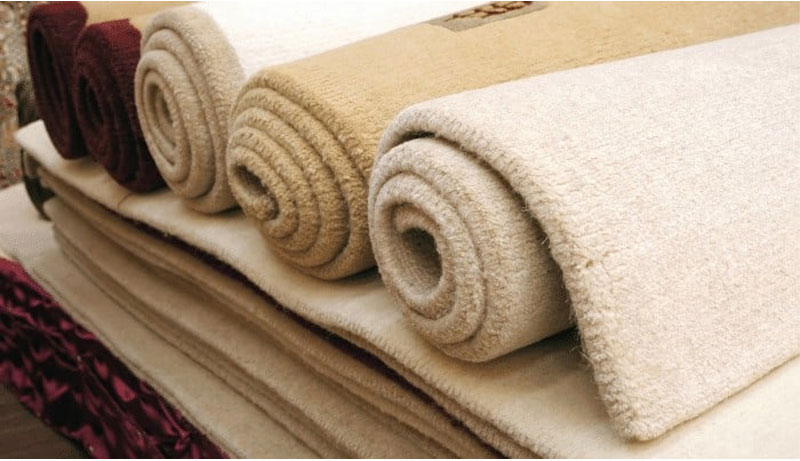Are you tired of your worn-out carpets and considering upgrading to wood floors or stained concrete during your renovation? If so, it’s crucial to think about how to dispose of your old carpets properly. The Environmental Protection Agency (EPA) reports that approximately 500 million kilograms of carpets are discarded in the United States each year, and carpets take decades to break down in landfills. Recycling carpets is the sustainable solution to this waste problem, but it’s not as simple as it may seem.
For effective carpet recycling, all contaminants must be removed. Today, I will walk you through the entire carpet disposal process and explain why tossing your old carpets away isn’t the best choice.
Sustainable Ways to Dispose of Your Carpet
To learn how to dispose of carpets responsibly, your first step should be to locate carpet recycling facilities in your area. This increases the likelihood that your old carpets will be recycled or disposed of in an eco-friendly manner.
If your carpet is in good condition, consider donating it as your initial course of action. This is especially true for leftover carpet from a recent installation rather than older ones that have seen over 20 years of use. However, even if it’s old, but still in decent shape, exploring donation options is worthwhile.
If donation isn’t an option, your next move should be to seek out carpet recyclers. Start by contacting local flooring businesses to inquire about their recycling services. Let’s delve deeper into these disposal methods.
1. Local Flooring Businesses
Many local flooring companies offer recycling services or collection programs for used carpets. It’s crucial to contact them in advance to understand the specifics of their offerings.
Some businesses may provide these services only to paying customers, while others might have restrictions on carpet dimensions and condition. Some may even offer moving services, which can be convenient during the disposal process.
2. Manufacturer Take-Back Programs
Several carpet manufacturers have implemented take-back programs, such as Interface Flooring. These programs allow you to return your old carpet, which is then recycled to create new flooring materials. This initiative helps divert thousands of pounds of old carpet from landfills. Keep in mind that some of these programs are primarily available to for-profit businesses, but it’s worth investigating.
3. Reuse or Donate Your Old Carpets
Don’t overlook the option of repurposing or donating your old carpets. They can find new life in gardens, as flooring in non-pristine areas, as animal bedding, or as offcuts for various purposes. However, it’s essential to note that fresh offcuts are more likely to be reused since old carpets may have issues like mustiness, fading, and wear.

Selling a worn-out and unkempt carpet is challenging, so consider offering it for free through charitable organizations or online platforms like Freecycle. For carpets in reasonable condition, you can explore selling options on platforms like eBay, Instagram Marketplace, and Gumtree.
In conclusion, disposing of your old carpets responsibly not only benefits the environment but also opens up opportunities for reuse and recycling. So, when the time comes to replace those worn-out carpets, remember these sustainable options for a greener and more eco-friendly renovation process.
4. Consult Your Local Waste Management Company
Another viable option is to get in touch with your local waste management company regarding carpet recycling or disposal. You can find their contact information online or in the phone book. Reach out to them via phone or email to inquire whether they accept used carpets for recycling or disposal.
Before taking any action, review their guidelines and requirements for preparing the carpet for recycling or disposal. Always verify the proper handling and removal procedures with your local waste management company before discarding any sizable or potentially hazardous items.
5. Collaborate with Waste Collection Services
Carpets can be included in your regular household trash, but keep in mind that your local waste collection company may have restrictions on the amount of old carpet they accept. In such cases, you might need to transport the carpet to a designated trash collection site or wait for bulk garbage pickup days.
We strongly recommend reaching out to your local rubbish collection agency in advance rather than assuming they won’t accept the carpet. Some companies may offer pickup services for used carpets, while others may require you to handle the transportation yourself.
Another convenient option is hiring a garbage collection service that can pick up trash from your property. This eliminates the need to transport the carpet to a disposal site, saving you both time and effort.
6. Repurpose Old Carpets for Soundproofing
An innovative solution to address noise pollution is repurposing old carpets as sound absorbers. Small carpet sections can be strategically placed under appliances like dryers and washers to significantly reduce noise levels.
Additionally, in workshops or garages, carpets can serve as effective muffling mats, lowering the decibel levels produced by machinery and power tools. These creative and practical applications not only reduce waste but also enhance the soundproofing of your home or workplace.
Can Carpets Be Recycled?
Absolutely, carpets can be recycled, and in fact, most types of carpet are recyclable. The recycling process involves breaking down carpets into their fundamental components, which can then be used to create new products. Recycled old carpets find new life in the form of various items, such as carpet padding, plastic lumber, auto parts, and more.
It’s important to note that while nearly all carpet types are recyclable, carpets are composed of multiple layers of various materials, including fibers and plastic. Because these materials don’t readily decompose in landfills, many municipalities do not accept carpets and other household waste for disposal. The most effective way to recycle a carpet is to drop it off at a designated and approved garbage disposal facility.
Carpet padding, the material beneath the carpet, can also be recycled. In fact, recycling carpet padding is often simpler than recycling the carpet itself because it typically consists of a single material rather than the complex layers found in carpets. Most recycling facilities that accept carpets also welcome carpet padding.
However, it’s important to note that recycling carpet and carpet padding separately is not always feasible. The padding should be dry when recycling, and you can easily roll it up and take it to a local carpet disposal facility. Be sure to remove any contaminants or debris from the carpet padding before recycling.
Is Carpet Biodegradable?
Yes, carpets are biodegradable, but they decompose very slowly and at a gradual pace. This slow decomposition means that carpets can continue to impact the environment in landfills for many years. The specific type of fibers used in the carpet’s construction will determine how long it takes for the carpet to break down.
For instance, nylon, a commonly used carpet material in the US, can take up to 40 years to degrade in a landfill. However, today’s market offers a range of environmentally friendly carpet options. Carpet tiles, made from recycled materials, are a popular choice and can be easily replaced in case of damage.
Another eco-friendly carpet option is broadloom carpet, which is crafted from natural materials like cotton, wool, or sisal. These carpets tend to be more expensive but are often more durable and sustainable compared to synthetic carpets. How Many Amps Does A Garage Door Opener Use?
Local Regulations Regarding Carpet Disposal
In certain regions and municipalities, the placement of dumpsters in residential or commercial right-of-way areas may be prohibited. If such limitations or permits are required for renting a garbage container at your property, we recommend that you contact the relevant city or local office for further information and to initiate the permitting process.

If a permit is indeed necessary for the placement of a dumpster at your home or business location, it should be arranged well in advance of the scheduled delivery date. Additionally, if your residence falls under a homeowners’ association, it’s advisable to inquire about any potential restrictions or guidelines regarding the rental of dumpsters. Some homeowners’ associations might impose restrictions on the types of dumpsters allowed or the duration for which they can be placed in front of your property.
Environmental Impact of Carpet Disposal
The environmental consequences of carpet disposal are comparable to those of other plastics. When 2,460,000 pounds of carpet waste are dumped in landfills, they decompose very slowly, potentially persisting for hundreds of years. During this lengthy decomposition process, emissions are released, and there’s a risk of hazardous chemicals leaching into the soil and water.
In cases where carpets are not sent to landfills, they are often incinerated, leading to the generation of potentially harmful pollutants and greenhouse gas emissions. Synthetic carpet fibers can also contribute to the growing problem of microplastics, which can harm various levels of the food chain when not disposed of in appropriate waste streams.
Disposing of carpets in landfills is akin to discarding plastics because neither readily breaks down, leaving a lasting negative impact on the environment. Here are several reasons why you should consider alternatives to carpet disposal:
- Carpet fibers are complex and durable, making them challenging to disintegrate. When carpets are incinerated in landfills, they release pollutants into the air.
- Rotting or burning carpets can contaminate the air and water, posing risks to both humans and wildlife.
- The disposal of carpets results in the release of fossil fuels required for their incineration.
- Carpet fibers can be repurposed into various products, including insulation and new carpets. Additionally, fabrics in good condition can be recycled into paper.
- Recycling carpet-derived materials reduces the need for fossil fuels in the manufacturing process, thus lowering carbon emissions.
- Carpets constitute a significant portion of waste, accounting for 1% of total waste and 2% of all urban solid garbage volume.
By opting to recycle carpets, you not only reduce the burden on landfills but also contribute to the creation of valuable materials for future manufacturing endeavors, thereby promoting a more sustainable and environmentally responsible approach to carpet disposal.
FAQ
1: How can I dispose of my old carpet responsibly?
Answer: To dispose of your old carpet responsibly, consider recycling it. Look for carpet recycling facilities in your area, contact your local waste management company for guidance, or explore manufacturer take-back programs. Donating the carpet if it’s in good condition or repurposing it for soundproofing are also eco-friendly options.
2: Can I include my old carpet in regular household trash pickup?
Answer: While it’s possible to include old carpet in regular household trash pickup, many waste collection services have restrictions on the amount and size of carpet they accept. It’s advisable to check with your local waste collection agency beforehand or consider alternative disposal methods to ensure responsible carpet disposal.
3: Is it necessary to separate carpet padding from the carpet when recycling?
Answer: In most cases, carpet padding should be separated from the carpet when recycling. However, carpet padding should be dry before recycling. You can usually take both the carpet and padding to a local recycling facility, ensuring they are clean and free from contaminants.
4: How long does it take for carpets to decompose in a landfill?
Answer: Carpets can take a very long time to decompose in a landfill, potentially lasting for hundreds of years. The exact duration depends on the materials used in the carpet’s construction, with synthetic materials like nylon taking even longer to break down.
5: Are there any environmental benefits to recycling carpets?
Answer: Yes, recycling carpets offers several environmental benefits. It helps reduce the burden on landfills, conserves resources by reusing materials, lowers greenhouse gas emissions associated with carpet production, and promotes a more sustainable approach to waste management. Recycling carpets is a responsible choice with positive environmental impacts.
In Conclusion
Eco-friendly carpets are reshaping the carpet industry by offering a sustainable and environmentally conscious flooring option. These carpets are crafted from eco-friendly materials, minimize waste, and are produced with ethical practices in mind. While they may come with an initial cost premium compared to traditional carpets, they offer numerous long-term cost-saving benefits.
As environmental awareness continues to grow among consumers, the demand for sustainable carpets is expected to rise. In response, the carpeting industry will need to adapt and evolve to meet this increasing demand for eco-friendly flooring solutions. The future of carpets lies in their ability to align with our commitment to a greener and more sustainable world.





Leave a Reply